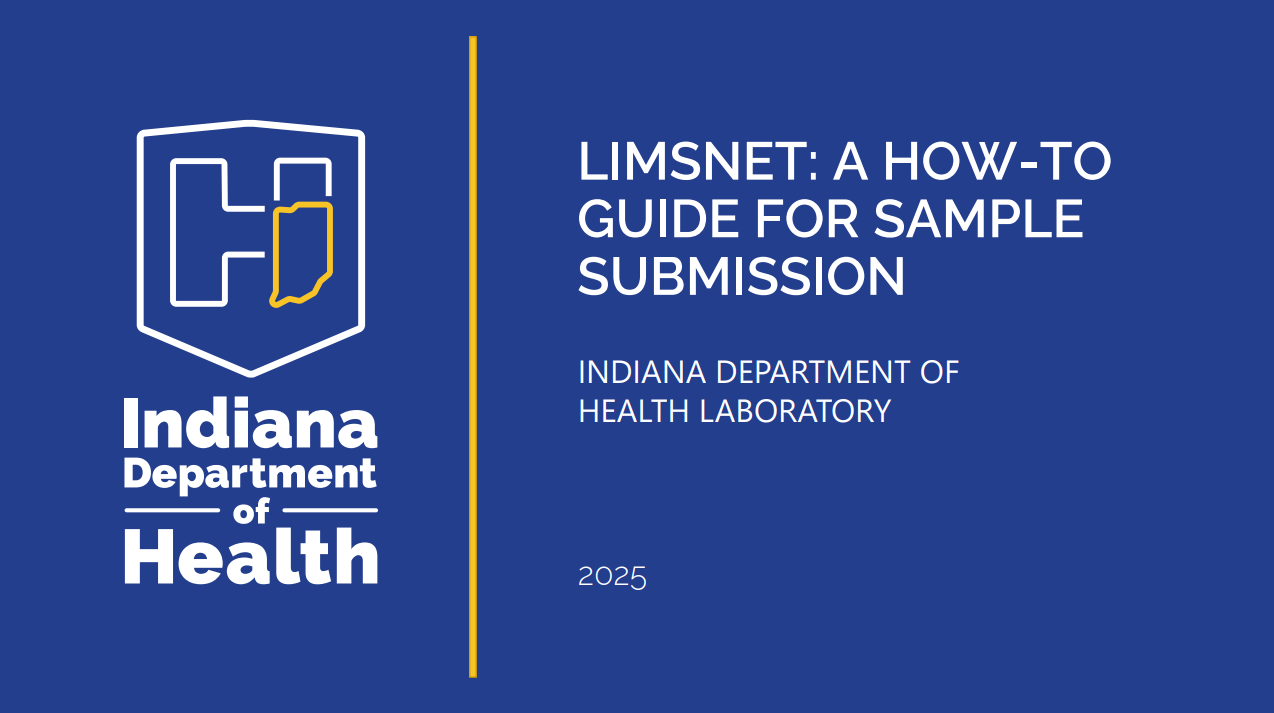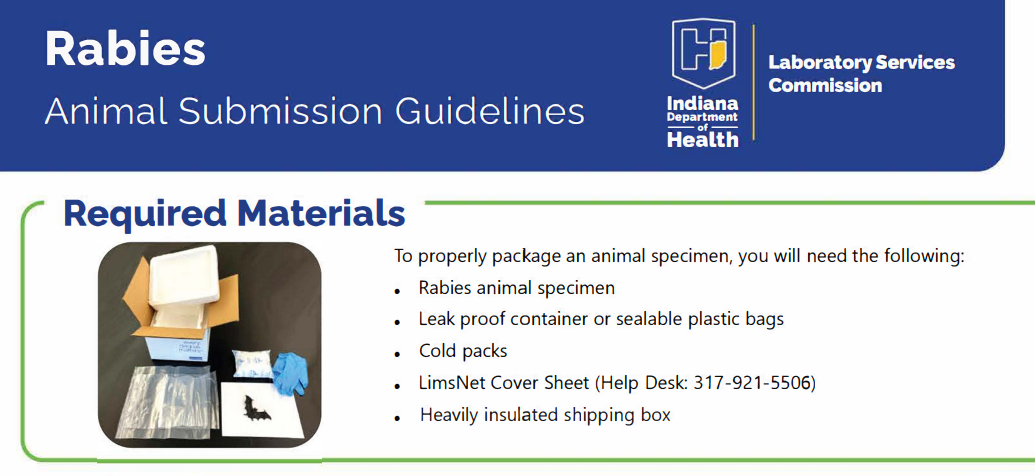Rabies Testing
Samples analyzed according to the CDC guidance for postmortem diagnosis of rabies in animals by direct fluorescent antibody testing.
Detection of rabies virus in animals.
No cost for this testing.
- Since brain tissue is examined for the diagnosis of rabies, only the animal head will be accepted for diagnostic purposes. Animals should be euthanized in a manner that will not damage the brain. The neck should be severed at the midpoint between the base of the skull and shoulders.
- For bats, the entire dead animal should be submitted.
- Only fresh, non-fixed tissue is acceptable.
The IDOH Rabies Laboratory requires that animal specimens meet the following criteria before accepting and testing specimens:
- Any animal that has bitten or otherwise exposed a human, pet or livestock: Observation of dogs, cats, and ferrets for 10 days is required unless the animal is unable to be observed due to injuries, illness at the time of the incident, or becomes ill during the observation period. Submission of a dog, cat, or ferret under other circumstances requires prior notification and approval of the IDOH Public Health Veterinarian. Any other domestic or wild animal that is suspected of being rabid, has bitten or otherwise exposed a human, pet, or livestock should be submitted as soon as possible.
- Bats that have been involved in biting or non-bite exposures with humans or animals: Bats found in living space of human dwellings where people have been sleeping (an individual awakens to find a bat in the room, or an adult observes a bat in a room with an unattended child, or a mentally disabled or intoxicated person) may be submitted even though actual exposure cannot be confirmed. Bats found sick, dying, or dead outdoors where there is no known or suspected exposure to humans or domestic animals should not be submitted.
- Terrestrial species that are known to be rabies vectors in Indiana and other states (skunks, foxes, raccoons, coyotes) whose actions suggest abnormal behavior or central nervous system (CNS) disease may be submitted whether a bite or non-bite exposure to a human or animal has occurred. These animals will be tested for surveillance purposes. Squirrels, mice, hamsters, gerbils, rats, or other animals that have a very low or non-incidence of rabies will not be tested unless there is a human bite or other exposure involved and with prior approval of the IDOH Rabies Epidemiologist or Public Health Veterinarian.
- Brain material from animals with CNS disease symptoms may be submitted by veterinarians or veterinary diagnostic laboratories as part of their diagnostic process, regardless of bite or other exposure status.
- Leak-proof containers (e.g., heavy-duty, sealable plastic bags).
- Cold packs.
- Zip-lock bag for LimsNet coversheet.
- Insulated shipping boxes/containers.
- All specimens should be stored at refrigerator temperature (2-8C) until shipped. Freezing of specimens is discouraged under normal circumstances because it may delay testing, as it may take up to 24 hours to thaw.
- If multiple specimens are shipped in the same container, be sure each specimen is labeled appropriately. The lab must be able to match the specimen with the information on the LimsNet coversheet.
- Specimens should be submitted via LimsNet, the IDOH Labs electronic submission and results reporting system. To get a free LimsNet account established at your facility, call the help desk at 317-921-5506, or send an email to LimsAppSupport@health.in.gov.
- Place animal head specimens or whole bat specimens in a leak proof container (e.g., double bag using heavy-duty plastic bags or a metal can with lid) and seal tightly.
- Place the leak proof container in an insulated shipping carton (e.g., Styrofoam shipper) with sufficient cold packs to maintain refrigeration temperature during shipment. Do not use wet ice.
- Place the completed examination form in a zip-lock bag before placing it in the shipping container.
- Place the insulated shipping carton into a cardboard shipping box, close lid, and seal.
- Shipment via courier service is usually the most rapid method of delivery. At this time, United Parcel Service (UPS) and FedEx will accept specimens for delivery to the IDOH Labs if properly packaged. Consult with your local UPS or FedEx representative to obtain the most current shipping/packaging
requirements.
- Positive rabies test results will be reported immediately by telephone to both the local health department officials and the submitter of the rabies specimen. The laboratory report will be available to the submitting facility and the local health department via LimsNet.
- Reports for negative test results are available to the submitting facility and the local health department via LimsNet.
TAT: 1-2 business days
Do you need assistance on how to successfully submit a rabies specimen in LimsNet? Please refer to the training PowerPoint below.
LimsNet: A How-to Guide for Sample Submission

To learn how to properly pack and ship a rabies specimen, please refer to the poster below.
Rabies: Animal Submission Guidelines